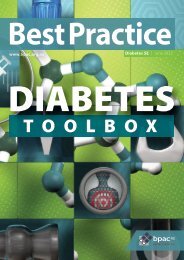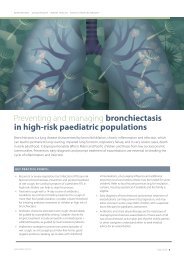You also want an ePaper? Increase the reach of your titles
YUMPU automatically turns print PDFs into web optimized ePapers that Google loves.
Table 1: Effects of diabetes medicines (excluding insulin) on HbA 1c<br />
, cardiovascular co-morbidities, progression of kidney disease,<br />
weight and risk of hypoglycaemia. Adapted from the American Diabetes Association (<strong>2020</strong>) 19<br />
Medicine<br />
lowering HbA 1c<br />
CVD<br />
HF<br />
chronic kidney<br />
disease<br />
Efficacy for<br />
Cardiovascular effects Renal effects:<br />
progression of<br />
Effects on<br />
weight<br />
Risk of<br />
hypoglycaemia<br />
Metformin<br />
High<br />
Potential<br />
benefit<br />
Neutral<br />
Neutral<br />
Neutral with<br />
potential for<br />
modest loss<br />
Low<br />
Sulfonylureas High Neutral Neutral Neutral Gain High<br />
Pioglitazone<br />
High<br />
Potential<br />
benefit<br />
Increased risk Neutral Gain Low<br />
Vildagliptin Intermediate Neutral Neutral Neutral Neutral Low<br />
SGLT-2<br />
inhibitor * †<br />
Intermediate<br />
Benefit:<br />
empagliflozin,<br />
canagliflozin<br />
Benefit:<br />
empagliflozin,<br />
canagliflozin,<br />
dapagliflozin<br />
Benefit:<br />
empagliflozin,<br />
canagliflozin,<br />
dapagliflozin<br />
Loss<br />
Low<br />
GLP-1 receptor<br />
agonist * †<br />
High<br />
Benefit;<br />
lixisenatide is<br />
neutral<br />
Neutral<br />
Benefit:<br />
liraglutide<br />
Loss<br />
Low<br />
* Not funded<br />
† Preferred choice to add to metformin in patients with cardiovascular disease, heart failure or chronic kidney disease 19<br />
When to seek further advice<br />
Consider discussing patients with a diabetes specialist if<br />
appropriate management and adherence to treatment is<br />
ineffective in controlling progression of disease, e.g. HbA 1c<br />
> 75<br />
mmol/mol, declining renal function, significant albuminuria or<br />
other uncontrolled diabetes or cardiovascular complications.<br />
For the original and extended version of this article see:<br />
“A rising tide of type 2 diabetes in younger people: what can<br />
primary care do” (available at: https://bpac.org.nz/2018/<br />
diabetes.aspx)<br />
References<br />
1. Ng M, Fleming T, Robinson M, et al. Global, regional, and national prevalence of<br />
overweight and obesity in children and adults during 1980-2013: a systematic<br />
analysis for the Global Burden of Disease Study 2013. Lancet 2014;384:766–81.<br />
doi:10.1016/S0140-6736(14)60460-8<br />
2. Ministry of Health NZ. Living well with diabetes. Ministry of Health NZ<br />
2015. Available from: www.health.govt.nz/publication/living-well-diabetes<br />
(Accessed Jul, <strong>2020</strong>).<br />
3. Coppell KJ, Mann JI, Williams SM, et al. Prevalence of diagnosed and<br />
undiagnosed diabetes and prediabetes in New Zealand: findings from the<br />
2008/09 Adult Nutrition Survey. N Z Med J 2013;126:23–42.<br />
4. Huo X, Gao L, Guo L, et al. Risk of non-fatal cardiovascular diseases in earlyonset<br />
versus late-onset type 2 diabetes in China: a cross-sectional study. Lancet<br />
Diabetes Endocrinol 2016;4:115–24. doi:10.1016/S2213-8587(15)00508-2<br />
5. Dabelea D, Stafford JM, Mayer-Davis EJ, et al. Association of type 1<br />
diabetes vs type 2 diabetes diagnosed during childhood and adole<strong>sce</strong>nce<br />
with complications during teenage years and young adulthood. JAMA<br />
2017;317:825–35. doi:10.1001/jama.2017.0686<br />
6. Al-Saeed AH, Constantino MI, Molyneaux L, et al. An inverse relationship<br />
between age of type 2 diabetes onset and complication risk and mortality:<br />
the impact of youth-onset type 2 diabetes. Diabetes Care 2016;39:823–9.<br />
doi:10.2337/dc15-0991<br />
www.bpac.org.nz<br />
Best Practice Journal – SCE Issue 1 13









